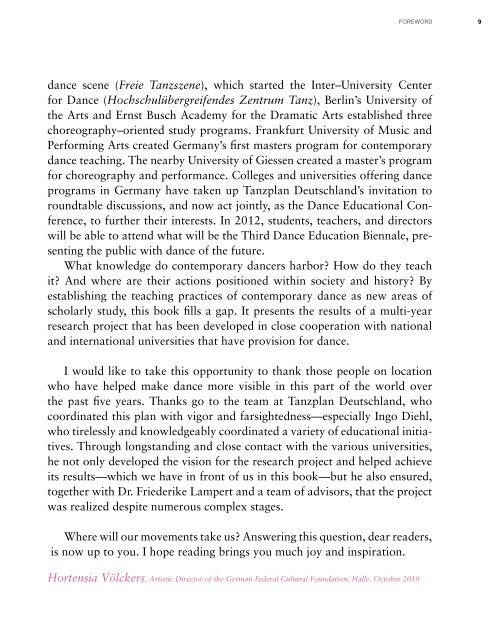Dance Techniques 2010
What does today's contemporary dance training look like? Seven research teams at well known European dance universities have tackled this question by working with and querying some of contemporary dance s most important teachers: Alan Danielson, Humphrey/Limón Tradition, Anouk van Dijk, Countertechnique, Barbara Passow, Jooss Leeder Technique, Daniel Roberts Cunningham Technique, Gill Clarke Minding Motion, Jennifer Muller Muller Technique, Lance Gries Release and Alignment Oriented Techniques. This comprehensive study includes interviews, scholarly contributions, and supplementary essays, as well as video recordings and lesson plans. It provides a comparative look into historical contexts, movement characteristics, concepts, and teaching methods. A workbook with two training DVDs for anyone involved in dance practice and theory. Ingo Diehl, Friederike Lampert (Eds.), Dance Techniques 2010 – Tanzplan Germany. With two DVDs. Berlin: Henschel 2011. ISBN 978-3-89487-689-0 (Englisch) Out of print.
What does today's contemporary dance training look like? Seven research teams at well known European dance universities have tackled this question by working with and querying some of contemporary dance s most important teachers: Alan Danielson, Humphrey/Limón Tradition, Anouk van Dijk, Countertechnique, Barbara Passow, Jooss Leeder Technique, Daniel Roberts Cunningham Technique, Gill Clarke Minding Motion, Jennifer Muller Muller Technique, Lance Gries Release and Alignment Oriented Techniques.
This comprehensive study includes interviews, scholarly contributions, and supplementary essays, as well as video recordings and lesson plans. It provides a comparative look into historical contexts, movement characteristics, concepts, and teaching methods. A workbook with two training DVDs for anyone involved in dance practice and theory.
Ingo Diehl, Friederike Lampert (Eds.), Dance Techniques 2010 – Tanzplan Germany. With two DVDs. Berlin: Henschel 2011. ISBN 978-3-89487-689-0 (Englisch) Out of print.
You also want an ePaper? Increase the reach of your titles
YUMPU automatically turns print PDFs into web optimized ePapers that Google loves.
Foreword<br />
9<br />
dance scene (Freie Tanzszene), which started the Inter–University Center<br />
for <strong>Dance</strong> (Hochschulübergreifendes Zentrum Tanz), Berlin’s University of<br />
the Arts and Ernst Busch Academy for the Dramatic Arts established three<br />
choreography–oriented study programs. Frankfurt University of Music and<br />
Performing Arts created Germany’s first masters program for contemporary<br />
dance teaching. The nearby University of Giessen created a master’s program<br />
for choreography and performance. Colleges and universities offering dance<br />
programs in Germany have taken up Tanzplan Deutschland’s invitation to<br />
roundtable discussions, and now act jointly, as the <strong>Dance</strong> Educational Conference,<br />
to further their interests. In 2012, students, teachers, and directors<br />
will be able to attend what will be the Third <strong>Dance</strong> Education Biennale, presenting<br />
the public with dance of the future.<br />
What knowledge do contemporary dancers harbor? How do they teach<br />
it? And where are their actions positioned within society and history? By<br />
establishing the teaching practices of contemporary dance as new areas of<br />
scholarly study, this book fills a gap. It presents the results of a multi-year<br />
research project that has been developed in close cooperation with national<br />
and international universities that have provision for dance.<br />
I would like to take this opportunity to thank those people on location<br />
who have helped make dance more visible in this part of the world over<br />
the past five years. Thanks go to the team at Tanzplan Deutschland, who<br />
coordinated this plan with vigor and farsightedness—especially Ingo Diehl,<br />
who tirelessly and knowledgeably coordinated a variety of educational initiatives.<br />
Through longstanding and close contact with the various universities,<br />
he not only developed the vision for the research project and helped achieve<br />
its results—which we have in front of us in this book—but he also ensured,<br />
together with Dr. Friederike Lampert and a team of advisors, that the project<br />
was realized despite numerous complex stages.<br />
Where will our movements take us? Answering this question, dear readers,<br />
is now up to you. I hope reading brings you much joy and inspiration.<br />
Hortensia Völckers, Artistic Director of the German Federal Cultural Foundation, Halle, October <strong>2010</strong>


















